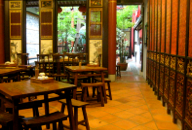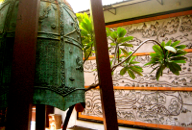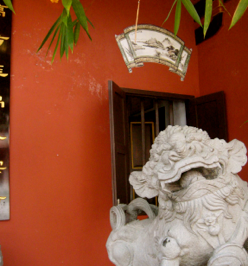ZHENG HE TEA HOUSE
17, Jin Tukang Besi
Malacca/Melaka
State of Malacca, southern peninsula,malaysia
February 28, 2009


ZHENG HE TEA HOUSE
17, Jin Tukang Besi
Malacca/Melaka
State of Malacca, southern peninsula,malaysia
February 28, 2009




Henry and I decided to round out our Chinese lunch experience by having tea afterwards in a nearby historic tea house. We were directed to a small open doorway and a narrow brick and ivy lined passageway which took us from Jin Tukan Besi, aka Heeren Street, running parallel to Jonker Street. This “secret” back entrance was historically used by some of the tea shop’s customers who sought opium, smoked here in carved and inlaid pipes during the 19th century. We walked into the tea shop through an open courtyard dominated by a huge cast bronze bell. Low stools sat at a long table, backed by an open screen that shielded the main room of the establishment. We were approached by the owner, who suggested we sit at a table in the room paneled with red and black lacquered wooden screens. These screens were decorated with Chinese symbols, calligraphy, carved in wood and painted gold. After inquiring about our choice of tea, she sat down with us as we discussed the various attributes of the traditional Chinese teas on the menu. We chose a mild “white” tea, imported from China, over the more acidic Green tea which she claimed most tourists ordered. She disappeared for a few minutes, only to return with a metal pot filled with boiling water, and a small bowl of sesame peanut brittle, cut into tiny portions. It was THEN that her “Kung Fu” (as she called it) Tea Ceremony began. Before her was a raised box made of carved wood, the top pierced with openings that allowed the water to drain into it. First, she poured hot water into the tiny tea cups, then into and over the small clay tea pot. She explained she was washing and warming these elements, preparing them for the tea. Next she took a nice portion of white tea and placed it inside the tiny clay tea pot, then filled it with piping hot water. After several minutes, she transferred the brewed and steeped tea to an open pitcher, added more water to dilute the strength, then filled our little Chinese tea cups with tea. She cautioned us about the temperature and suggested we take small sips, like drinking wine. The tea was fresh, hot and delicious. Pak explained to us about the Chinese philosophy of tea, the art of which she practiced in the Zheng He Tea House. Put into words, the philosophy might be outlined as “Teapot Artistry” as follows:
“The beauty of form, the inspiration of the ancients and the skill of the artisans. Like tea itself, teapots grow in stature to become an important facet of tea history. For thousands of years, artisans delighted us with their superb skill transforming tea pots into objects of art. Some of these have been passed down to us to be valued and priceless collectibles. Presented here we can better understand and appreciate this ancient form that has been transformed into a great tradition to complete and compliment the art of tea drinking.”
Pak went on to explain that a teapot needs to be used in order to have life. A teapot which has been penetrated with the color of tea is filled with life with the love of its use. For her, a collector of teapots, even a highly valued teapot would lose its value if it is not in constant use, We chatted about the shop, Malacca, the Majestic Hotel, and our one friend in common, Donovan, our historian and guide. We also talked about what it would mean for Malacca to become a World Heritage Site -- both pro and con. After a few minutes, Pak, meaning “White” poured more boiling hot water into and over the tea pot to freshen and heat the tea. We were invited to visit the adjoining museum, though declined, since the skies were threatening a late afternoon shower.
PHOTOS: Left Column: 1. View of the garden court from the main room of the Zheng He Tea House. 2. Entrance to the Zheng He Tea House. 3. Pak enacting her “Kung Fu Tea Ceremony”. 4. Pouring the tea. Center, Top: Entering the narrow “secret” back entrance of the tea house. Center, Bottom: One of a pair of carved stone lions which protect the entrance to the Zheng He Tea House. Right Column: 1 The red lacquered screen, one of two screens which panel the main room of the Zheng He Tea House. 2. The elaborately carved beamed ceiling in the tea house. 3. View of the main room of the tea house with the black lacquered screen paneling in the background. 4. View of object d’art in the center garden court: the cast bronze bell and a three-dimensional mural.


TRADITIONAL CHINESE TEA






